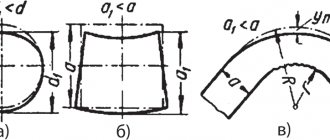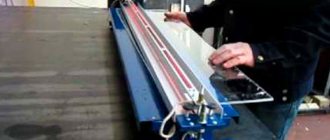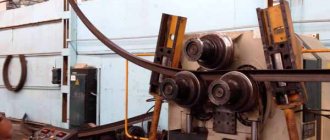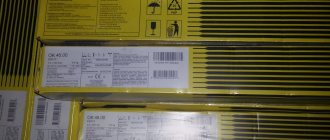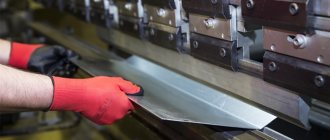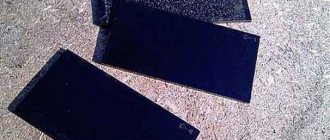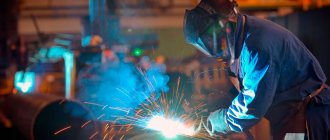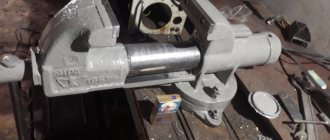The Cherepovets plant has been manufacturing metal structures for small and large enterprises for more than 55 years. You can order sheet metal straightening from us.
What it is? Metal straightening is the process of removing irregularities on the surface of a product. The straightening operation is used both for blanks and for ready-made structures. The procedure is resorted to when the product does not meet the specified characteristics, or when it is excessively convex or curvature. You can straighten metal yourself at home.
Types of blanks
A coil of knitting wire.
All types of rolled products produced can be eliminated from defects using deformation methods. Waviness, warping, and folds on the sheets are quite common ; the wire has to be straightened from the coils to be used in the technological process. Profile pipes and other workpieces of this configuration need to be restored to straightness and eliminate twisting around the longitudinal axis.
In the process of producing a finished part, it is necessary to use the technological operation of editing to eliminate residual deformations that arose at intermediate stages of the technology, for example, after welding, cutting, punching.
Types of metal straightening
There are the following types of metal straightening:
- manual;
- mechanical.
In the first case, the work is carried out at home. Mechanical straightening can be carried out both with a heated part and in a cold state. Often a hot stamping die consists of several strands. The last of these is used to level the part after it has been formed in the previous streams. When the two halves of the stamp are closed, the finished product is refined
In sheet stamping, in addition to preliminary alignment of the metal sheet, editing is necessary after certain operations:
- When bending and stretching, the correct bend radius and the amount of rounding are not always formed. In this case, the stamp is lowered to its lowest position. All residual stresses are eliminated and the part acquires the required parameters.
- If the sheet thickness is large, separate dies are made for straightening. A grid of small teeth is applied to the working parts of the instrument. Alignment occurs at the moment of closure of both halves of the stamp.
Straightening equipment
Editing of metal products in production conditions is carried out on machines. The following equipment is used for this:
- Correct rollers. As a tool, shafts are installed, between which metal is passed. The pressure is calculated so that it is enough to correct the defect, but does not exceed the plasticity of the material. Often the equipment is automated and therefore has high productivity. Rolls come in different shapes, so not only sheet metal, but also rods are passed between them.
- Press. They require the installation of stamps. Often editing, also called embossing, is combined with other operations in one die.
In case of manual editing, the following tool is used:
- Cast iron plates. Characterized by heavy weight.
- Straightening headstocks. Used for working with hard materials.
- Hammers. Depending on the metal being processed, there are different configurations.
- Sledgehammers. The same hammers, only heavier. They are used if the hammer impact force is not enough to deform.
- Mallets - a wooden hammer.
- Ironing irons. They are made of wood and are designed to level metal.
Mallet for straightening metal
Why is editing needed?
Rolled products produced by metallurgical methods are used as a starting material for hot or cold stamping. Therefore, products must meet all GOST standards:
- sheets and strips are checked for flatness;
- round rods with permissible bending value;
- square rods on the degree of bulging or concavity of the metal.
It is important to know when to correct distortion of the workpiece shape. If such a defect is present, there is a risk of damage to the stamping equipment. The curved workpiece, falling into the plane of the stamp, is formed by a punch and a matrix.
In addition, editing of products is necessary in the following cases:
- when cutting sheet metal using guillotine shears;
- when pushing the finished part out of the die cavity;
- after metal shrinkage;
- after heat treatment.
How to straighten sheet metal
Sheet metal straightening
The difficulty of straightening sheet metal depends on what type of defect the sheet has - a waviness on the edge, or a bulge, or a dent in the middle of the sheet, or both at the same time (Fig. 15).
Rice. 15. Techniques for straightening sheet metal: a – with a deformed middle of the sheet; b – with deformed edges of the sheet; c – using a wooden trowel; d – using a metal smoother.
When straightening a convexity, blows must be applied starting from the edge of the sheet towards the convexity (Fig. 15 a, b).
The most common mistake is that the hardest blows are applied to the place where the convexity is greatest, and as a result, small indentations appear in the convex area, which further complicates the uneven surface. In addition, the metal in such cases experiences very strong tensile deformation. You need to do just the opposite: the blows should become weaker, but more frequent, as the edit approaches the center of the convexity. The sheet of metal must be constantly rotated in a horizontal plane so that the impacts are evenly distributed over its entire surface.
If the sheet has more than one convex section, but several, you must first reduce all the convex areas into one. To do this, strikes with a hammer in the intervals between them. The metal between the protrusions is stretched, and they combine into one. Then you need to continue editing in the usual way. If the middle of the sheet is smooth, and the edges are distorted by waves, then the sequence of blows when editing should be the opposite: they should be applied starting from the middle, moving towards the curved edges (Fig. 15, b). When the metal in the middle of the sheet stretches, the waves on its edges will disappear.
Very thin sheets cannot be straightened even with hammers made of soft material: they will not only leave dents, but can also tear the thin metal.
In this case, smoothing bars made of metal or wood are used for straightening, with which the sheet is smoothed on both sides, turning it periodically. The quality of editing can be checked using a metal ruler.
Anyone who has taken on the task of straightening a steel sheet knows that this work is quite difficult: while you straighten one bend, others appear on the sheet. However, this can be avoided and thus make the work much easier. The steel sheet must be laid for straightening not on a smooth plate, as is usually done, but on a backing plate with many small blunt tubercles evenly spaced on its surface. In this case, the quality of work should increase, and labor intensity should decrease. The metal, under the blows of a rubber hammer, will seem to find its place on its own. At the same time, barely noticeable waves are formed on the sheet; when puttying and painting, they will begin to fill in and help ensure that the putty and paint adhere very firmly to the metal. Irregularities after metal coating are completely invisible. The only difficulty is how to make the required backing plate. It is really difficult to make it at home: tubercles are usually obtained by cutting a large number of mutually intersecting grooves located close to each other on a smooth slab. This can be done on a planing or milling machine, so if there is such an opportunity, it is better to take advantage of it.
Read also: Oxygen metal cutting technology
Straightening and bending of metal
Straightening sheet material in metalworking is the process of straightening metal sheets, blanks and parts that are bent or have local dents and kinks. Using straightening, strip and rod metal, metal tubes, and wire are also straightened.
Straightening is done manually on a smooth steel plate (straightening plate) or
Editing (straightening) of metal
:
anvil. To straighten small parts, you can use a piece of steel I-beam or trough-section beam (channel).
The surface of the slab on which editing is carried out must be flat and free of potholes and dents.
Sheet metal straightening. and parts of large thickness are produced with metalworking hammers. Sheets up to 1 mm thick are straightened with mallets, and very thin sheets are smoothed with straight bars made of hardwood or steel. Thin foil is straightened by smoothing it onto a sheet of paper with your finger or a wad of cotton wool.
The strikers of hammers and mallets used for straightening must be even and smooth. When straightening parts and sheets made of soft non-ferrous metals, lead and aluminum hammers are often used.
When straightening, sheet metal is laid on the slab with the convex or fold upward. Strikes with a hammer or mallet are applied first along the edges of the sheet, then closer to the center of the convexity. In this case, the blows should be stronger along the edges of the convexity.
Sheets of soft non-ferrous metal - aluminum, copper, brass, so that there are no marks left on their surface from blows with a hammer or mallet, are often covered with a piece of cardboard when editing.
Straightening (straightening) of wire is usually done by drawing: the wire is clamped between two wooden blocks and pulled once or twice. To straighten it, it is enough to stretch a thin wire, pulling strongly, around some round metal rod or wooden block, for example, a door handle, a chisel clamped in a tie, etc. Thick steel wire, as well as bar metal, is straightened steel plate with hammer or mallet blows.
Straightening of metal tubes is carried out on a stove. This work, especially if the tubes are made of soft metals or have thin walls, must be carried out with careful blows of a mallet so as not to crush the walls. In this case, the tubes must be rotated around their axis.
Read also: Power control on a triac
Bending small parts made of wire, strips of tin and non-ferrous metals is done by hand using pliers, round nose pliers, oval nose pliers and pliers. Larger parts are bent in a vice. Bending sheet metal at right and acute angles, for example when bending edges in various models, is conveniently done on a long steel angle fixed along the edge of the workbench cover.
For minor work on bending edges of sheet metal parts, a so-called scraper is used - a thick T-shaped steel plate, which is clamped in a vice during operation.
When manufacturing various volumetric parts from sheet metal, the workshop should have steel bars of square and round sections, which are fixed on the workbench so that one end hangs down.
When making parts of various models - oil, gasoline and steam pipelines, pumps, etc. - young technicians often have to bend metal tubes. Bending of metal tubes is carried out according to templates or directly according to drawings made in full size.
Copper, brass and aluminum tubes of small diameters (up to 4-5 mm) can be bent in a cold state and without packing. Tubes of large diameters, so that their deformation does not occur at the bend points (the cross-sectional shape does not change and folds do not form), are tightly packed with well-dried fine quartz sand before bending. For this purpose, wooden plugs are hammered into both sides of each tube. When filling a tube with sand, in order for the sand to be well compacted, the walls of the tube are tapped with a hammer.
Tubes of relatively large diameters (12-15 mm and more), especially if the radii of the curves along which they bend are small, are filled with sand and are well heated at the bend. Often, such tubes have to be bent in two or three steps, each time heating the tube at the bend, etc.
Almost all “metal work” begins with straightening the metal. A happy exception is the case when you receive a completely new sheet or piece of profile from the warehouse.
- steel sheets made of non-ferrous metals and their alloys;
- steel strips;
- pipes;
- rod material and wire.
Metal welded structures are also subject to editing.
Machine "GOCMAKSAN STORM 1601".
Definition of the term “metal straightening”
Metal straightening is an operation that consists of eliminating defects in parts and workpieces: curvature (convexity or concavity), irregularities (curvature, warping, etc.), etc. It consists of compressing a convex layer of metal or expanding a concave one and is carried out the action of pressure on any part of the workpiece or part.
Read also: Why does a chainsaw stall at idle?
Editing methods and techniques
There are two main methods for straightening any metals:
- manually. Performed with a hammer on anvils, steel leveling plates, etc.
- machine. Produced on straightening machines (presses or rollers).
The metal is edited in a cold or heated state. The choice is determined by the magnitude of the deflection and its size and workpiece material.
When straightening metal, it is of great importance:
- correct choice of place to strike;
- measuring the force of the impact with the amount of curvature of the metal. It should be reduced as you move from maximum to minimum bending.
If the strip is bent “on the edge”, blows should be applied with the toe of a hammer. This will lead to one-sided stretching (lengthening) of the bend. The stripes, which represent a “twisted bend,” are adjusted in the direction of unwinding. The check is carried out at the initial stage “by eye”, and at the end - on a surface plate or with a straight edge. Metal rods should be straightened on an anvil or plate from edge to middle.
Let us dwell on the consideration of sheet metal straightening, since this is the most difficult operation. The sheet of metal should be placed on the plate with its convex side up. We will strike with a hammer from the edge of the sheet towards the deformed part. Under the influence of directed blows, the flat part of the sheet will be stretched, and the convex part will be straightened. When straightening sheets of hardened metal, frequent but gentle blows with the toe of a hammer should be applied in the direction from the concavity to its edges. In this case, the upper layers of the metal will stretch, and the defect in the part will be eliminated.
Equipment and tools used
The following equipment is used for straightening metal:
- correct plate;
- straightening headstocks.
The tools used are hammers with round, radius or insertable soft metal strikers. Thin sheet metal is straightened with a wooden hammer (mallet).
The correct slab should be massive. Therefore, it can have dimensions, mm: 400 x 400... 1500 x 3000. This tool is installed on wooden or metal supports, ensuring stability and horizontal position.
To straighten hardened parts, straightening heads are used, which are made of steel with subsequent hardening. The headstocks have a spherical or cylindrical working surface, the radius of which is 150...200 mm.
Machine "VPK PRO-14 KOMPAKT".
Popular brands and models of machines
The following models are very popular:
- straightening machine of the Promtekhosnastka brand, model GT 4-14;
- straightening and cutting machine of the Antares brand, model VPK PRO-14 COMPACT;
- straightening and cutting machine of the GROST brand, model SCM6-12C.
Where can I buy
;
The company produces and sells straightening and cutting machine GT 4-14.

